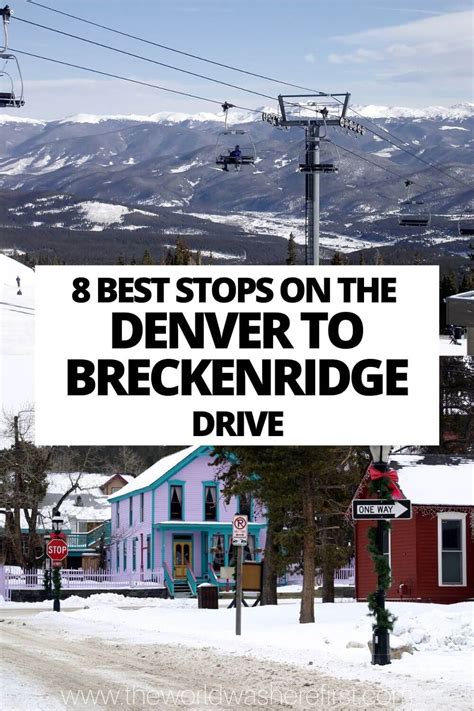Mastering the Denver to Breckenridge Drive: A Guide for Every Season
The drive from Denver to Breckenridge is more than just a journey; it's an experience. This iconic Colorado route offers breathtaking mountain vistas, charming towns, and plenty of opportunities for adventure. Whether you're a seasoned mountain driver or a first-timer, mastering this drive requires preparation and awareness. This comprehensive guide will equip you with everything you need for a safe and unforgettable trip.
What's the Best Route from Denver to Breckenridge?
The most common and generally preferred route is via I-70 West. This is a well-maintained highway, but it can be congested, especially during peak seasons. While seemingly straightforward, navigating this route effectively requires understanding potential challenges and alternative options.
I-70 West: The Main Route
This is the fastest route, typically taking around 2 hours without traffic. However, be prepared for potential delays due to:
- Traffic Congestion: Weekends and holidays see significant traffic, particularly near the mountain towns. Consider leaving early or traveling mid-week to avoid delays.
- Road Conditions: Winter weather can drastically impact travel times. Check road conditions before you depart and be prepared for snow and ice. Chains may be required.
- Construction: Construction projects along I-70 are not uncommon. Check the Colorado Department of Transportation (CDOT) website for updates.
Alternative Routes (for specific situations):
While I-70 is the most efficient, alternative routes exist, though they are generally longer:
- US-285: This is a more scenic, but significantly longer route. It offers a quieter drive and avoids some of the I-70 congestion. However, be prepared for a much longer travel time.
- Loveland Pass (US 6): This route offers stunning views but is only suitable for experienced drivers in good weather conditions. It is notoriously challenging in winter and should be avoided unless you are confident in your driving abilities and have the right vehicle and equipment.
What are the Best Stops Along the Way?
The drive itself is a highlight, but strategically planned stops enhance the experience.
Idaho Springs: A Historic Mining Town
This charming town, situated along I-70, offers a glimpse into Colorado's mining history. Stop for a bite to eat, explore the shops, or visit the Argo Gold Mine & Mining Museum.
Georgetown: A Picturesque Victorian Village
Georgetown, a beautifully preserved Victorian town, offers stunning views and opportunities for hiking. It's slightly off I-70 but worth the detour.
Clear Creek Canyon: A Scenic Drive
The drive through Clear Creek Canyon offers breathtaking views of the canyon and the Clear Creek River. Pull over at scenic overlooks for memorable photos.
What Should I Pack for the Drive?
Preparation is key to a smooth and enjoyable drive. Pack accordingly for the season:
- Winter: Chains, warm clothes, blankets, emergency kit (jumper cables, flashlight, first-aid kit, snacks, water), and a full tank of gas.
- Summer: Sunscreen, hats, water, comfortable shoes for hiking, and snacks.
What are the common issues faced on the Denver to Breckenridge drive?
Several common issues can arise during this drive:
Altitude Sickness: The elevation gain is significant. Take it easy on arrival, stay hydrated, and be aware of symptoms like headache, nausea, and shortness of breath.
Weather Changes: Mountain weather is unpredictable. Be prepared for sudden changes, even during summer.
Wildlife: Keep an eye out for wildlife, especially deer and elk, which can unexpectedly cross the road.
How long does it take to drive from Denver to Breckenridge?
The drive typically takes between 1.5 to 2.5 hours without traffic. However, this can significantly increase during peak seasons or in challenging weather conditions. Always check real-time traffic and road conditions before you depart.
What is the best time of year to drive from Denver to Breckenridge?
The best time to drive depends on your priorities:
- Summer (June-August): Ideal for hiking, biking, and other outdoor activities. Expect higher traffic and potentially higher prices.
- Fall (September-October): Stunning fall foliage. Cooler temperatures and fewer crowds than summer.
- Winter (November-April): Great for skiing and snowboarding. Be prepared for snow, ice, and potential road closures. Chains may be required.
- Spring (May): Melting snow can lead to unpredictable road conditions, so it's best to check road reports before departing.
By carefully planning your trip and heeding these tips, you'll be well-prepared to master the Denver to Breckenridge drive and create lasting memories of this beautiful Colorado journey. Remember to prioritize safety and enjoy the spectacular scenery along the way!

